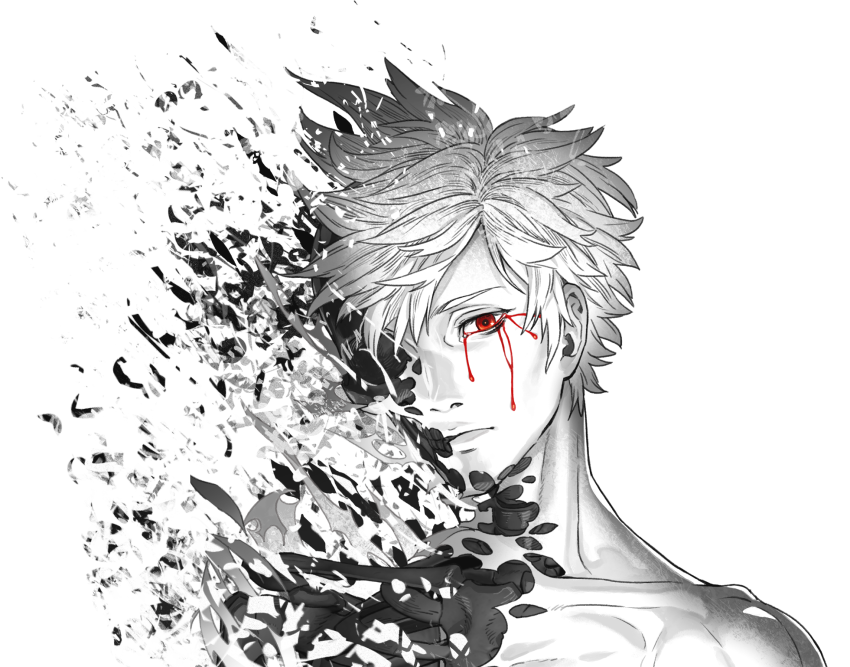Human Lost
February 15, 2021 · 0 comments
By Jonathan Clements.
 Tokyo, 2036. A revolution in medical treatments has conquered death. Thanks to the SHELL system, which controls a benign plague of nanomachines, human beings no longer suffer from diseases or death. A 120-year lifespan is entirely possible, but this glimpse of quasi-immortality has also warped modern Japan. Drunk on their own extended lifespans and immunity from consequences, the rich have become decadent and exploitative – the poor lack the resources to buy into the SHELL system’s promise of long life and happiness. The environment continues to collapse, and a faction of dissenters, the “Human Lost”, voluntarily disconnect from the SHELL network, plunging their bodies into nightmarish internal cataclysms of uncontrolled nano-shutdown.
Tokyo, 2036. A revolution in medical treatments has conquered death. Thanks to the SHELL system, which controls a benign plague of nanomachines, human beings no longer suffer from diseases or death. A 120-year lifespan is entirely possible, but this glimpse of quasi-immortality has also warped modern Japan. Drunk on their own extended lifespans and immunity from consequences, the rich have become decadent and exploitative – the poor lack the resources to buy into the SHELL system’s promise of long life and happiness. The environment continues to collapse, and a faction of dissenters, the “Human Lost”, voluntarily disconnect from the SHELL network, plunging their bodies into nightmarish internal cataclysms of uncontrolled nano-shutdown.
Out beyond Route 16 in the pollution-riddled slums, the drug-addicted Yozo Oba (Mamoru Miyano) runs into Masao Horiki (Takahiro Sakurai), an associate of the drag-racing gangs from the city limits. The pair embark upon an illegal quest inside the Route 7 loop, to the inner-city utopia where the rich isolate themselves from the poor, where Oba encounters not only the victims of the Human Lost fad, but also Yoshiko Hiiragi (Kana Hanazawa), a girl with special powers, working for the HILAM agency that fights against the Lost.
Tow Ubukata, a writer best known outside Japan for his scripts for PSYCHO-PASS and Ghost in the Shell: ARISE, returns with a cyberpunk script that extends multiple roots into different eras of Japanese dystopias. A two-tiered Tokyo, riven between entitled aristocrats and underclass bikers evokes Katsuhiro Otomo’s Akira, while the rise of a manifestly different younger generation recalls the 1970s science fictions of the New Breeds and the Newtypes. But Human Lost draws on much older sources in Japanese fiction, born from the beginning of the modern era, when writers began to deal with the consequences of pollution, both environmental and physical. There are echoes here of Tora Kizu’s The Wedding Shrouded in Grey (1927), set in a world reeling from the effects of gas weaponry, but most obviously and deeply, Osamu Dazai’s classic novel No Longer Human (1948), one of the most widely read works in modern Japanese literature.
In the original, semi-autobiographical novel, the protagonist Oba was a lost soul who ran into Horiki at a painting class. Horiki turns out to be a bad influence, dragging Oba into a vicious cycle of drugs, booze and womanising, which ends with Oba plotting a (failed) double-suicide with his married mistress. After a series of bungled affairs and encounters, he starts to redeem himself through a career in cartooning (no, really) and the love of a good woman, only for the return of Horiki to drag him back into his bad ways. The novel has a notoriously downbeat ending, coloured inevitably by the fact that its author himself committed suicide shortly after completing it. Confined to a mental asylum, the narrator proclaims: “I had now ceased utterly to be a human being.”
Although a semi-fictionalised account of a bad-boy author sounds like a weird inspiration for a cutting-edge anime movie in 2019 from Fuminori Kizaki, the director of Afro Samurai, it is oddly in keeping with Dazai’s spirit. Although many a Japanese student comes face-to-face with his famous novels No Longer Human and The Setting Sun, fewer dig deeper into his short stories, many of which upgraded and updated older tales in new times. The recently reissued collection Blue Bamboo includes several of his retellings of old Chinese and Japanese fairy stories, as well as the sardonic “Lanterns of Romance”, a cynical sequel to the story of Rapunzel that lifts whole passages verbatim from Hans Christian Andersen’s Snow Queen.
Dazai’s dissolute life-style and his powerful presence in the genre of confessional Japanese fiction has skewed much of his legacy. For many of those who come to his work as set books in school, he is the bohemian wastrel who wrote self-indulgent tales about feeling sorry for himself, a self-professed libertine kicking against the injustices and hypocrisies of the post-war era. Ubukata’s anime adaptation, however, plays with Dazai’s self-identification as a “decadent” (burai) and maps it onto science-fictional issues in body augmentation. “Human” turns out to be an acronym, standing for the Health Utility Maintenance Agreement Network, while Yoshiko’s HILAM agency is the “Human Intelligence Laboratory Mechanist” organisation, armed with “device swords” with vibrating brains to penetrate the hard skins of the Lost, and built-in hypodermics that force poison into their innards.
Human Lost soon turns into a treasure trove of references and call-backs to many moments in Japanese literary history, much like Masayuki Miyaji’s Fuse: Memoirs of a Hunter Girl toyed with the legacy of a century of Japanese pulp fictions. The year, for example, is “Showa 111” – playfully extending Emperor Hirohito’s imperial era as far as the year 2036. But does this mean that this anime takes place in a world where the Showa Emperor has been ruling for 111 years? Is Hirohito still on the Chrysanthemum Throne, a wizened, cyber-emperor in his thirteenth decade, sustained by dark technologies and underhand upgrades? Now that’s an idea for an anime.
Jonathan Clements is the author of Anime: A History. Human Lost is released in the UK by Manga Entertainment.
anime, Fuminori Kizaki, Human Lost, Japan, Jonathan Clements, Osamu Dazai, Scotland Loves Anime, Studio Polygon
Leave a Reply